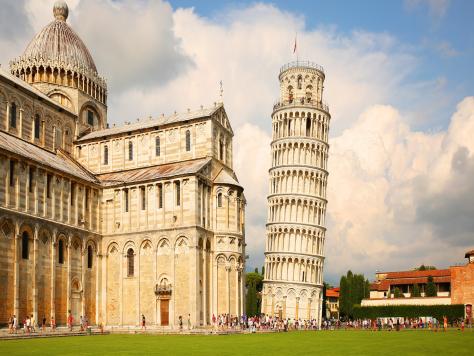Leaning Tower of Pisa
Frangarto, Bolzano, Italy, Europe

Customized Activity
You are free to customize your itinerary exactly the way you want. Choose transport, hotel & sightseeing as per your desires.
Includes
Meals
Transport
Pick-up & Drop
Activities
Accomodation
About The Attraction
The Leaning Tower of Pisa or simply the Tower of Pisa is the campanile, or freestanding bell tower, of the cathedral of the Italian city of Pisa, known worldwide for its unintended tilt. The tower is situated behind the Pisa Cathedral and is the third oldest structure in the city's Cathedral Square (Piazza del Duomo), after the cathedral and the Pisa Baptistry.
The tower's tilt began during construction in the 12th century, caused by an inadequate foundation on ground too soft on one side to properly support the structure's weight. The tilt increased in the decades before the structure was completed in the 14th century. It gradually increased until the structure was stabilized (and the tilt partially corrected) by efforts in the late 20th and early 21st centuries.
The height of the tower is 55.86 metres (183.27 feet) from the ground on the low side and 56.67 metres (185.93 feet) on the high side. The width of the walls at the base is 2.44 m (8 ft 0.06 in). Its weight is estimated at 14,500 metric tons (16,000 short tons). The tower has 296 or 294 steps; the seventh floor has two fewer steps on the north-facing staircase. Prior to restoration work performed between 1990 and 2001, the tower leaned at an angle of 5.5 degrees, but the tower now leans at about 3.99 degrees. This means the top of the tower is displaced horizontally 3.9 metres (12 ft 10 in) from the centre.
Architect
There has been controversy about the real identity of the architect of the Leaning Tower of Pisa. For many years, the design was attributed to Guglielmo and Bonanno Pisano, a well-known 12th-century resident artist of Pisa, famous for his bronze casting, particularly in the Pisa Duomo. Pisano left Pisa in 1185 for Monreale, Sicily, only to come back and die in his home town. A piece of cast bearing his name was discovered at the foot of the tower in 1820, but this may be related to the bronze door in the façade of the cathedral that was destroyed in 1595. A 2001 study seems to indicate Diotisalvi was the original architect, due to the time of construction and affinity with other Diotisalvi works, notably the bell tower of San Nicola and the Baptistery, both in Pisa.
Construction
The Pisa Baptistery (in the foreground), the Pisa Cathedral (in the middleground), and the Leaning Tower of Pisa (in the background), Construction of the tower occurred in three stages over 199 years. Work on the ground floor of the white marble campanile began on August 14, 1173 during a period of military success and prosperity. This ground floor is a blind arcade articulated by engaged columns with classical Corinthian capitals.
The tower began to sink after construction had progressed to the second floor in 1178. This was due to a mere three-metre foundation, set in weak, unstable subsoil, a design that was flawed from the beginning. Construction was subsequently halted for almost a century, because the Republic of Pisa was almost continually engaged in battles with Genoa, Lucca, and Florence. This allowed time for the underlying soil to settle. Otherwise, the tower would almost certainly have toppled. In 1198, clocks were temporarily installed on the third floor of the unfinished construction.
In 1272, construction resumed under Giovanni di Simone, architect of the Camposanto. In an effort to compensate for the tilt, the engineers built upper floors with one side taller than the other. Because of this, the tower is curved. Construction was halted again in 1284 when the Pisans were defeated by the Genoans in the Battle of Meloria.
The seventh floor was completed in 1319. The bell-chamber was finally added in 1372. It was built by Tommaso di Andrea Pisano, who succeeded in harmonizing the Gothic elements of the bell-chamber with the Romanesque style of the tower. There are seven bells, one for each note of the musical major scale. The largest one was installed in 1655.
After a phase (1990–2001) of structural strengthening, the tower is currently undergoing gradual surface restoration, in order to repair visible damage, mostly corrosion and blackening. These are particularly pronounced due to the tower's age and its exposure to wind and rain.
Best Time
- Round_the_Year
Timings
- ~~Monday_Sunday